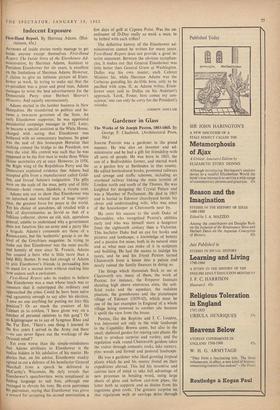Gardener in Glass
JOSEPH PAXTON was a gardener in the grand manner. He was also an inventor and ad- ministrator and he had a gift for friendship with all sorts of people. He was born in 1803, the son of a Bedfordshire farmer, and started work as a garden boy at Battlesden in that county. He edited horticultural books, promoted railways and sewage and traffic schemes, including an overhead railway linking the main termini of London north and south of the Thames. He was knighted for designing the Crystal Palace and was a Member of Parliament. He died in 1865 and is buried in Edensor churchyard beside his clever and understanding wife, who was niece of the housekeeper at Chatsworth near by.
He owes his success to the sixth Duke of Devonshire, who recognised Paxton's abilities early and who was himself more a hangover from the eighteenth century than a Victorian. This bachelor Duke had an eye for books and pictures and landscape, a knowledge of botany and a passion for stone, both in its natural state and as what man can make of it in sculpture and building. He had the means to indulge his tastes, and he and his friend Paxton turned Chatsworth from a house into a palace and nearly ruined the family finances in doing so.
The things which thousands flock to see at Chatsworth are, many of them, the work of Paxton; for instance, the Emperor fountain shooting high above enormous elms, the arti- ficial rocks and the aqueduct, the redolent pinetum, the greenhouses and the picturesque village of Edensor (1839-42), which must be one of the last examples in England of a whole village being removed to another site because it spoilt the view from the house.
Paxton, like the Reptons and J. C. Loudon, was interested not only in the wide landscape in the Capability Brown sense, but also in the small, sheltered garden for rearing rare plants. He liked to produce surprise and variety, and the regulation walk round Chatsworth gardens takes the visitor through romantic rocks, lake scenery, pine woods and formal and pastoral landscape.
He was a gardener who liked growing tropical plants which he and his master found on their expeditions abroad. This led his inventive and curious turn of mind to take full advantage of new processes in bending wood, using large sheets of glass and hollow cast-iron pipes, the latter both as supports and as drains from his ingenious glass roofs. The greatest surprise on that regulation walk or carriage drive through the gardens of Chatsworth must have been the great conservatory (1836-40), which was de- molished after the First World War. Here he created a huge tropic forest, complete with hum- ming birds and fairy lights, glassed in from the cold Derbyshire sky and with a carriage drive down the middle. Beautiful as was this conser- vatory within and without, Paxton did not think it a fit companion for a stone mansion and put it out of sight of the house. He was a man with the conventional aesthetic taste of his time.
Mr. Chadwick clearly establishes his case that Paxton did not think of himself as a pioneer of architecture in new materials. He designed the Crystal Palace of glass, iron and wood because he thought it was a cheaper and more practical exhibition hall than the original design. When he wanted 'beauty' he called in Owen Jones for the interior and Charles Barry for the outside, and very well they carried out their tasks. Pax- ton's own most successful and conscious attempts to create 'beauty' were in the planting of trees and the placing of winding walks and houses around the public parks he designed— Upton Park, Slough (1842-43), Birkenhead Park (1843-47), Buxton Park (1852), Princes Park, Liverpool (1842-44), Crystal Palace Park (1852- 56), Kelvingrove Park (1854) and Queen's Park (1860), Glasgow, Baxter Park, Dundee (1861-63), the People's Park, Halifax (1855-56), Hesketh Park, Southport (1864), the Public Park, Dun- fermline (1865). As an architect, where he usually employed assistants, he was not much good, for he seems to have thought of archi- tecture more as a matter of style than propor- tion, and his houses at Edensor seem clumsy beside those of his predecessor Wyattville.
Mr. Chadwick has sensible things to say, but takes 250 pages to do so. He chooses the longer word if he can find it. The excuse for the large rash of foot-and-note disease on his pages should be that the prose above it is clear and readable. No one will doubt Mr. Chadwick's accuracy, but his book is dry. Paxton was, after all, a typical, vigorous and 'progressive' Victorian, and just to read of his work without seeing the motives and character of the man behind it is enervating. Violet Markham's Paxton and the Bachelor Duke is more informative, though not so full about his work. I could have wished for a more generous allowance of illustrations and a more handsome format.
JOHN BETJEMAN



































 Previous page
Previous page